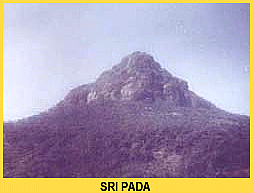

mailto: payer@hdm-stuttgart.de
Zitierweise / cite as:
Mahanama <6. Jhdt n. Chr.>: Mahavamsa : die große Chronik Sri Lankas / übersetzt und erläutert von Alois Payer. -- 20. Kapitel 20: Mahinda's vollkommenes Erlöschen. -- E1: Exkurs1 zu Kapitel 20: Verehrungsobjekte der Buddhisten heute. -- Fassung vom 2006-06-04. -- URL: http://www.payer.de/mahavamsa/chronik20e1.htm. -- [Stichwort].
Erstmals publiziert: 2001-07-12
Überarbeitungen: 2006-06-04 [Ergänzungen]
Anlass: Lehrveranstaltungen, Sommersemester 2001, 2006
Unterrichtsmaterialien (gemäß § 46 (1) UrhG)
©opyright: Dieser Text steht der Allgemeinheit zur Verfügung. Eine Verwertung in Publikationen, die über übliche Zitate hinausgeht, bedarf der ausdrücklichen Genehmigung der Herausgeberin.
Dieser Text ist Teil der Abteilung Buddhismus von Tüpfli's Global Village Library
Das folgende ist ein Kapitel aus dem sehr nützlichen Buch:
de Silva, L. A.: Buddhism : beliefs and practices in Sri Lanka. -- Colombo : Selbstverlag, 1974. -- S. 40 - 60
In answer to a question by the Buddha's devoted disciple, the Venerable Ananda Thera, the Buddha specified three objects proper to be worshipped or reverenced. They are:
The relics of his body which were to be collected after his cremation (saririka).
Those articles that he used (paribhogika) such as his alms-bowl, the girdle, the robes he put on when he bathed, the vessel from which he drank water, and his seat. With these is also included the Bodhi-tree under which he attained enlightenment.
Those things that have been erected on his account or for his sake which are reminiscent of him (uddesika).
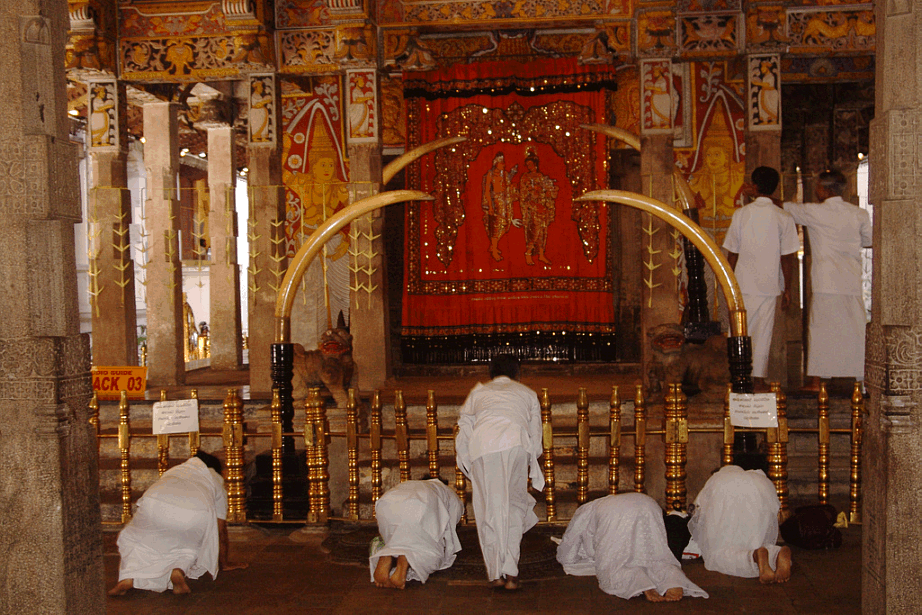
Abb.: Verehrung der Zahnreliquie Buddhas, Kandy
[Bildquelle: Jungle Boy. --
http://www.flickr.com/photos/jungle_boy/151322764/. -- Creative Commons
Lizenz. -- Zugriff am 2006-06-04]
Commentators say that this refers to the images of his person. In accordance with this threefold specification there arose in Buddhism:
Relic worship;
Worship of the Bodhi-tree; and
Image worship.
All these three are found practically in every monastery and they are to be worshipped in the above order.
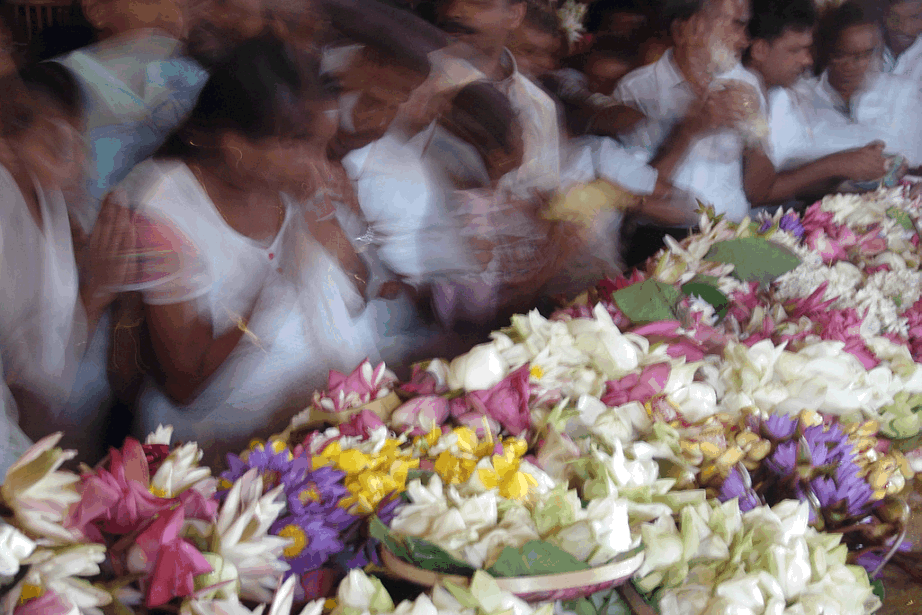
Abb.: Blumenopfer, Zahntempel, Kandy
[Bildquelle: Jungle Boy. --
http://www.flickr.com/photos/jungle_boy/145068591/. -- Creative Commons
Lizenz. -- Zugriff am 2006-06-04]
The average Buddhist visits the temple on four days in the month, known as Poya days. These are
the Full-moon day,
the New moon day and
the two quarters that fall in between.
Of these the Full moon day is of special significance. On these days he visits the temple with a tray of flowers and offers them at the above three places of worship, after having washed his hands as a mark of purity. He also lights small lamps and burns incense. In offering flowers he recites a stanza in Pali:
With these blossoms the Buddha I adore. With this merit may Nibbāna I attain. As this exquisite flower fades and die, so will my body wither and perish away.
By this act of merit he hopes that his mind will be purified and that thereby he will be able to obtain release from decay (anicca) to which all beings are subject.
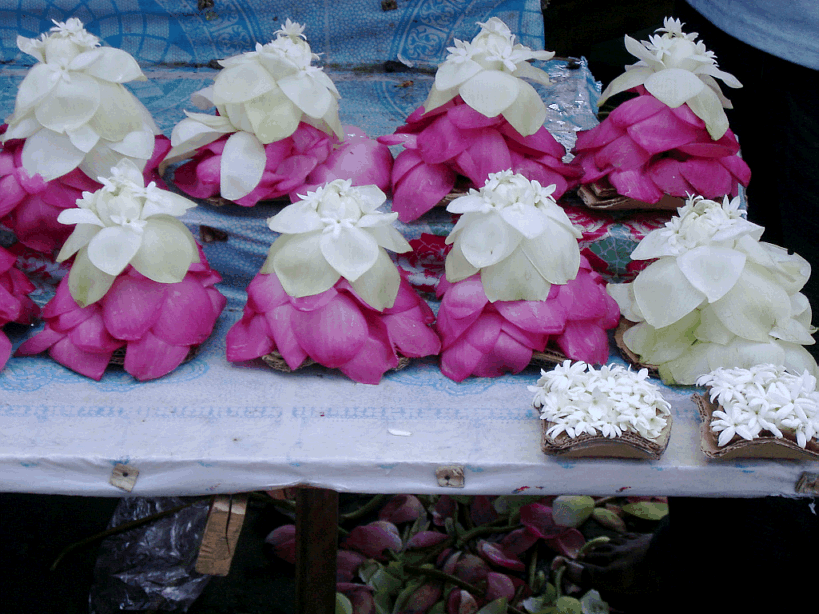
Abb.: Verkaufsstand mit Blumen für die Verehrung
[Bildquelle: José Willaert. --
http://www.flickr.com/photos/josewillaert/72852751/. -- Creative Commons
Lizenz. -- Zugriff am 2006-06-04]
The light symbolizes to him the wisdom and the enlightenment of the Buddha and the incense symbolizes purity.
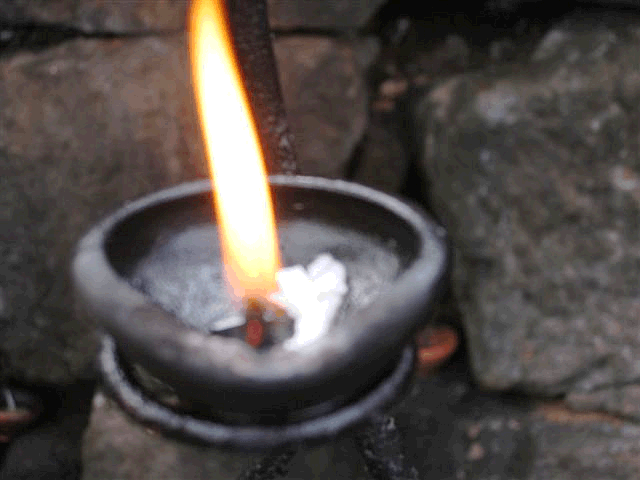
Abb.: Kokosöllampe
[Bildquelle: Dushiyanthini Kanagasabapathipillai. --
http://jayasrimahabodhi.blogspot.com/. -- Creative Commons Lizenz. --
Zugriff am 2006-06-04]
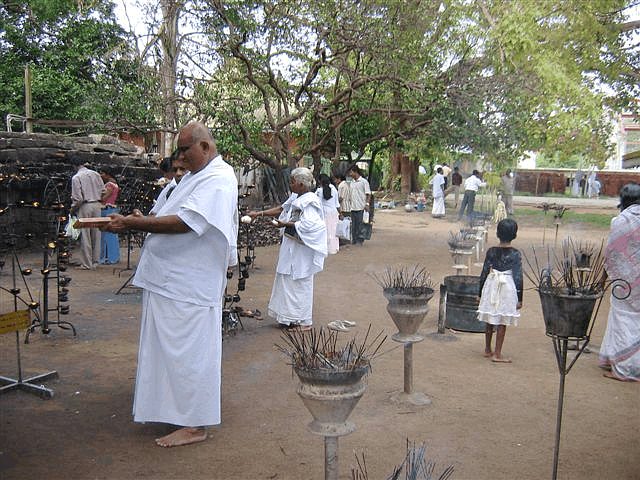
Abb.: Darbringung von Licht und Weihrauch am Mahābodhibaum, Anurādhapura
[Bildquelle: Dushiyanthini Kanagasabapathipillai. --
http://jayasrimahabodhi.blogspot.com/. -- Creative Commons Lizenz. --
Zugriff am 2006-06-04]
After reciting the above stanza he recites other stanzas, like the formula of the ninefold qualities of the Buddha, which help him to picture the Supremely Enlightened One whom he has undertaken to follow, and in such meditation he finds peace from the distractions of the world which enables him to be receptive to higher spiritual values. He ends up by sending out thoughts of mettā, or loving kindness to all beings alive or dead, and for himself he hopes that .his worship will bring him nearer the goal of life -- Nibbāna.
This worship is strictly individual. He may have the help of a monk to take the Five Precepts. On Poya days he sometimes takes the higher vows which include the above five and three further abstentions of taking meals after noon, of sitting on comfortable seats and of enjoying the pleasures of the senses by witnessing dancing, music, singing and the like. Some take the Ten Precepts which include two more abstentions, from touching gold or silver or money of any kind and from beautifying adornments, fragrant unguents and perfumes for the body. The Five Precepts are observed daily at home or at the temple. The other Precepts are observed on the Poya days, specially on the Full moon day when the devotees spend the day in meditation seated on mats in the temple premises. On these occasions the devotees wear simple white clothes and perform their religious rites bare-footed. People don't come in their "Sunday best" and no distinction is made between rich and poor, high and low. Simplicity and informality are the marked features of their worship.
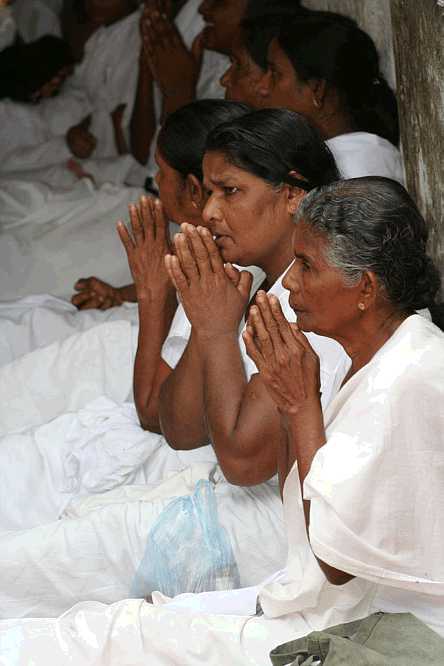
Abb.: Annahme der 8 Trainingspunkte der Sittlichkeit, Vollmondtag, Juni, 2005
[Bildquelle: amparabill. --
http://www.flickr.com/photos/billbarkle/20872707/. -- Creative Commons
Lizenz. -- Zugriff am 2006-06-04]
It is recorded in the Mahāparinibbāna Sutta that the Buddha, before he passed away, instructed Ananda Thera how, after his cremation, his corporeal relics should be treated:
This, Ananda, is the way they should treat the remains of the Tathāgata. A dāgaba should be erected over the remains of the Tathāgata. And whosoever shall there place garlands or perfumes, or lights, or makes salutations there, or become in its presence calm in heart, that shall long be to them, a profit and a joy.
Thus the erection of dāgabas has the sanction of the Buddha himself, and the worship at dāgabas is considered to bring great blessings.
A dāgaba (dagaba, dāgoba) is a memorial monument that entombs or enshrines the relics of the Buddha or his disciples, or other worthy individuals. The word dāgaba is derived from dā, dātu or dhātu, meaning corporeal relics, and goba or garbha, meaning womb. Dā-gaba or the Sanskrit word Dhātu-garbha therefore means relic chamber.
The words Thūpa (Skt: Stūpa) and cetiya (Skt: caitya) literally meaning "mound" or "tumulus", are also used interchangeably with dāgaba, but a Thūpa or Stūpa has a developed meaning of monument or mausoleum.
A dāgaba could be:
bell-shaped (Ghantākāra);
lotus-shaped (Padmākāra);
heap-of-paddy-shaped (Dhānyākāra);
up-turned-pot-shaped (Ghatākāra);
Nelli-fruit-shaped (Amalākārā); or
bubble-shaped (Bubbulākāra).
The Ceylon architects of old seem to have favoured the first second and last shapes for the construction of dāgabas.
Some of the dāgabas were of enormous size. The Abhayagiri Dāgaba, when it was originally built by King Vattagāmini Abhaya in the first century B.C., had a diameter of 327 feet and was 405 feet high, being only fifty feet less than the highest of the Pyramids of Egypt, or the dome of St. Peter's in Rome, and fifty feet higher than St. Paul's Cathedral in London.
Prior to this, two other thūpas of note were built. One was the Thūpārāmaya, built by King Devānampiyatissa in the third century B.C., having a diameter of 154 feet, and the other was the Ruwanweliya, built by King Dutugemunu in the second century B.C., having a diameter of 254 feet. The numerous smaller dāgabas found in every Buddhist monastery and elsewhere, are comparatively large edifices.
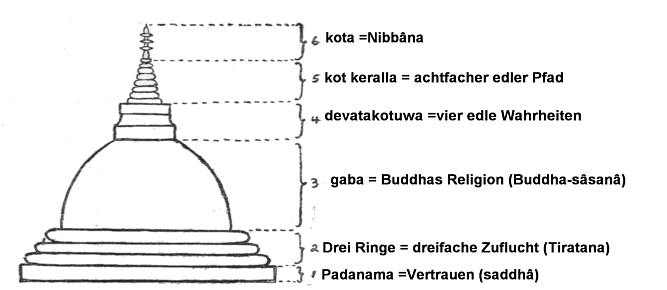
Abb.: Teile eines Dāgaba und ihre symbolische Bedeutung
A dāgaba is supposed to have a six-fold symbolical significance in the way in which it is constructed.
The base (Padanama) signifies confidence or faith (Saddhā) -- the sine qua non for spiritual progress along the path of purity.
The three rounds or rings at the point where the dome begins (parāvalalu) signify the Three Refuges (Tiratana).
The dome proper (gāba or garbhaya) signifies the dispensation of Buddha (Buddha-sāsanā).
The four side enclosures (devatākotuwa) signify the Four Noble Truths.
The tapering spirals (kot keralla), eight in number, signify the Noble Eight-fold Path.
The Pinnacle or Crown (kota) signifies Nibbāna, the goal of life.
In the construction of dāgabas these details are not consistently observed.
The Buddha decreed that four people, namely,
a Sammā Sambuddha (a fully awakened Buddha),
a Pacceka Buddha (Silent Buddha),
a Buddha Sāvaka (disciple of the Buddha), and
a Universal Monarch
were worthy of being honoured by the erecting of dāgabas enshrining their relics. But they are the dāgabas in which the relics of the Buddha are enshrined that receive the greatest homage and veneration.
As recorded in the Mahāparinibbāna Sutta, after the Buddha was cremated, the relics that were left were placed in a golden chamber by the Malla princes in the city of Kusinara. and honour, homage, respect and veneration were paid to them for seven days. After that they were divided into eight portions and given to the eight Kingdoms of India at the time, and dāgabas were built enshrining them.
With the introduction of Buddhism to Ceylon by Mahinda Thera in the 3rd century B.C., Ceylon became the proud custodian of some of the most important of the corporeal relics, such as the collar-bone of the Buddha, the left eye-tooth, the hair relic (Kesa-dhātu), the alms bowl, etc., not to mention the relics of the Buddha's disciples.
Whatever the relics are, the dāgabas enshrining them are treated with the greatest respect. Any mark of disrespect shown to a dāgaba is regarded with great disapproval. The enshrining of relics is done with great pageantry and festivity, people by the thousands participating in the ceremonies.
When a devotee enters a Buddhist monastery he has first to worship the dāgaba, circumambulating it in a meditative mood three times, keeping the object of worship to his right. If the dāgaba is a large one he has to stop and worship at four places. If small at eight places. In worship he either prostrates, kneels, squats or stands with hands cupped together. It is believed that such worship brings great merit. Thus the Buddha said to Ananda:
At the thought, Ananda, 'This is the Stūpa of the Blessed One, Perfect One, Fully enlightened One, the hearts of many people will be calmed and made happy; and so calm and vnth their minds established in faith therein, they at the breaking up of the body after death, will be reborn in a realm of heavenly happiness.
Speaking of the importance of making offerings to the thūpas, the Mahāvamsa says:
A wise man who perceives that only by inner faith in the Holy One is the way to heaven found, will therefore bring offerings to the thūpa.
It is with this inner faith that Buddhists worship the sacred relics enshrined in the dāgabas. They believe, as Benjamin Rowland says, that:
the relics, planted like a quickening seed in the womb of the structure, exert an external animating influence on this seemingly dead mass of masonry, generating and perpetuating for all time and all men the spiritual power of the Buddha. [The Art and Architecture of India: Buddhist, Hindu, Jain, p 267 Ch. 20, Note 2.]
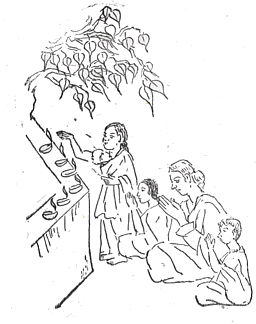
Abb.: Verehrung eines Bodhi-Baums
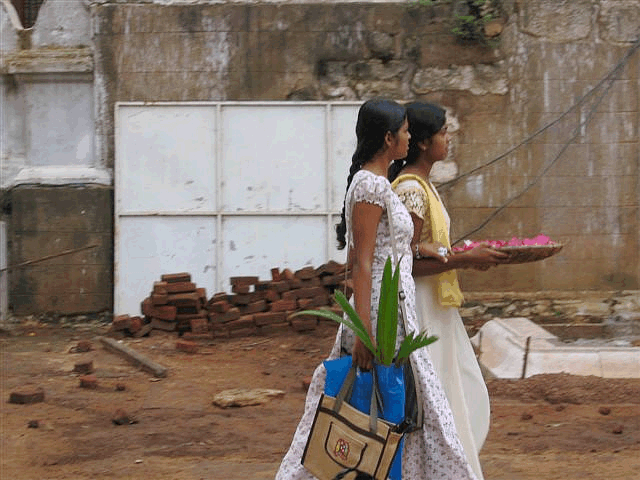
Abb.: Auf dem Weg zum Mahābodhibaum, Anuradhapura
[Bildquelle: Dushiyanthini Kanagasabapathipillai. --
http://jayasrimahabodhi.blogspot.com/. -- Creative Commons Lizenz. --
Zugriff am 2006-06-04]
Homage and veneration is paid to the sacred Bodhi Tree because under it the Buddha attained Enlightenment and after that paid his own respect to the Tree. He spent one whole week standing in front of it gazing with unblinking eyes full of gratitude and love. Later on he himself gave his sanction and authority to worship the Bo-tree at the request of some devotees. These devotees once brought flowers and perfumes to offer to the Buddha, to a monastery where he was residing at Sravasti, but since he was not there they were greatly disappointed and threw them down near the wall and went away. When Anepidu (a banker who became famous because of his unparalleled generosity to the Buddha) and the other upāsikas (lay devotees) saw what had happened they were grieved and wished that they had a permanent object of worship at which they might present their offerings during the absence of the Master. As the same disappointment occurred several times after that they made their wishes known to the Buddha's disciple, Ananda, who conveyed it to the Buddha. Then the Buddha said to Ananda:
The objects that are proper to receive worship are of three kinds, sāririka, uddesika and pāribhogika. In the last division is the tree at the foot of which I became Buddha. Therefore send to obtain a branch of that tree, and set it in the court of this Vihāra. He who worships it will receive the same reward as if he worshipped me in person.
It is believed that a branch of this very same Bodhi-Tree under which the Buddha attained enlightenment was brought to Ceylon in the reign of King Devānampiyatissa when Buddhism was first introduced to Ceylon. It was brought by Therî Sanghamittā, the sister of Mahinda Thera in 247 B.C. and planted in Anurādhapura, then the capital city of Ceylon, where it still stands up to this day and is claimed to be the oldest tree in the world.
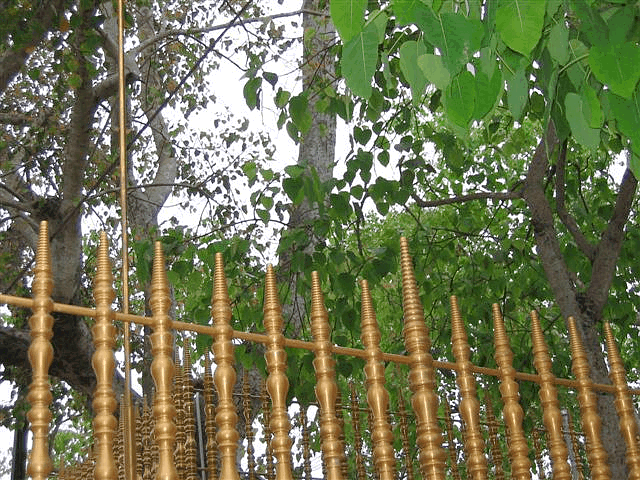
Abb.: Mahābodhibaum, Anurādhapura
[Bildquelle: Dushiyanthini Kanagasabapathipillai. --
http://jayasrimahabodhi.blogspot.com/. -- Creative Commons Lizenz. --
Zugriff am 2006-06-04]
Mention is made in the Mahāvamsa of the institution of an annual festival in connection with this tree by King Bhatika Abhaya (22 B.C. to 7 A.D.). It is known as the Bodhi isna pujā (Bathing the Bodhi tree). King Dhātusena (509-527 A.D.) too is mentioned as having celebrated this festival. So we could presume that it was regularly observed when Buddhism was flourishing in Anurādhapura. This festival is not forgotten even today by unsophisticated villager. When the season of drought, which lasts from July to October in the Northern parts of Ceylon is coming to an end, one could sometimes see long processions of villagers mostly women carrying pots of water on their heads, wending their way, with shouts of sādhu sādhu towards the sacred Bodhi tree and there pour the water. They believe that by so doing not only do they produce a store of merit by which they could ensure happy rebirths but also such action could cause the longed-for rain clouds to appear.
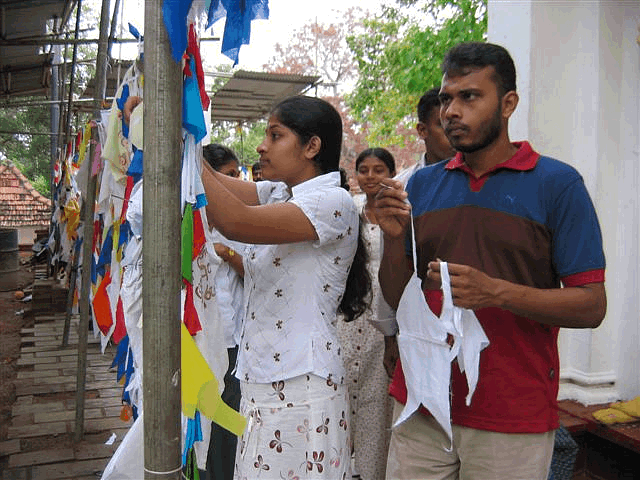
Abb.: Gläubige hängen bei Mahābodhibaum in Anurādhapura Fähnchen zu ihren
Wünschen und Gelübden auf
[Bildquelle: Dushiyanthini Kanagasabapathipillai. --
http://jayasrimahabodhi.blogspot.com/. -- Creative Commons Lizenz. --
Zugriff am 2006-06-04]
Within the premises of every monastery today there is a Bodhi-tree. In the early days the worship of the Bodhi-tree consisted of the offering of milk-rice (Kiri bath), bathing it with milk, the hanging of flags on its branches, and the making of vows. The custom of offering milk-rice and making vows prevails even today. For the purpose of making vows miniature Bo-trees made of either silver or gold are offered. There is a custom of hanging ornaments on the Bodhi-tree in Anurādhapura annually. There is a strong belief that a god resides in every Bodhi-tree. Some believe that the tree itself is a god. The homage and reverence paid to the Bodhi-tree are considered to be homage and reverence paid to the Buddha himself.
An interesting account of the Bo-tree at Anurādhapura is given in Sir Emerson Tennant's 'Ceylon' (Vol. ii. p. 643). The following is an abridged extract.
The Bo-tree of Anurādhapura is in all probability the oldest historical tree in the world. Its conservancy has been an object of solicitude to successive dynasties and the story of its vicissitudes has been preserved in a series of continuous chronicles.
It would almost seem to verify the prophecy pronounced when it was planted, that it would flourish and be green for ever.
The degree of sanctity with which this extraordinary tree has been invested by Buddhists, may be compared to the feeling of veneration with which Christians regard the attested wood of the Cross.
The other Bo-trees which are found in the vicinity of every temple in Ceylon are said to be all derived from the parent-tree at Anurādhapura, but they have been propagated by seeds; the priesthood adhering in this respect to the precedent recorded in the Mahāvamsa (when Mahinda himself, taking up a fruit as it fell, gave it to the king to plant), and objecting religiously to lop it with any weapon.
In the fifth century Fa-hien found the Bo-tree at Anurādhapura in vigorous health, and its guardians displaying towards it the same vigilant tenderness which they exhibit at the present day.
The author of the Mahāvamsa, who wrote between the years 459 and 478 of our era, after relating the ceremonial which had been observed nearly eight hundred years before, at the planting of the venerated tree by Mahinda, concludes by saying: 'Thus this monarch of the forest endowed with miraculous powers, has Stood for ages in Lanka, promoting the spiritual welfare of its inhabitants and the propagation of the religion.'
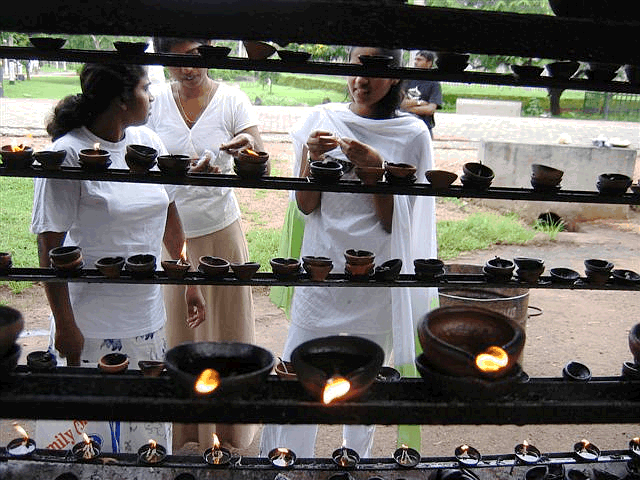
Abb.: Lichtopfer mit Kokosöl am Mahabodhi-Baum, Anuradhapura
[Bildquelle: HumanityAshore.org. --
http://www.flickr.com/photos/humanityashore/72541576/. -- Creative Commons
Lizenz. -- Zugriff am 2006-06-04]
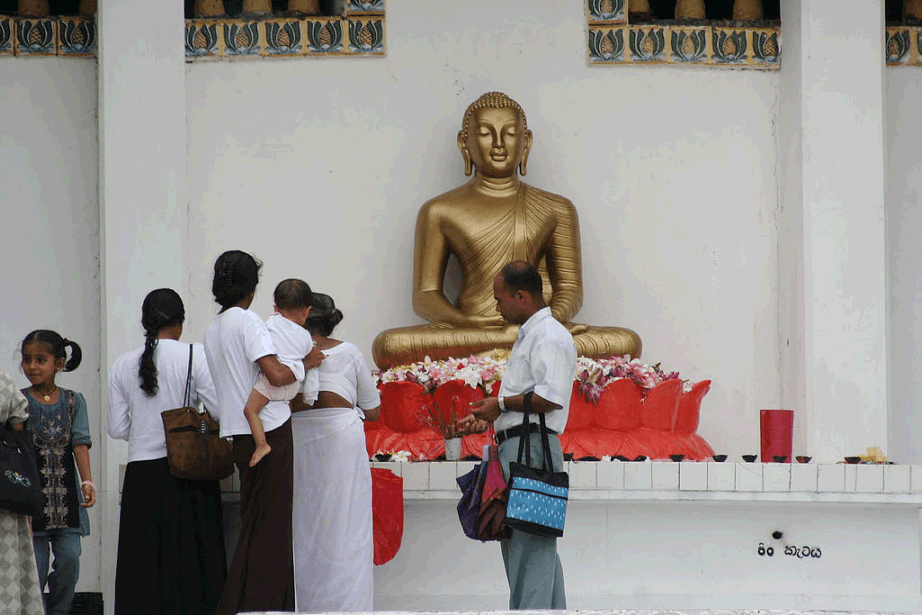
Abb.: Verehrung einer Buddhastatue im Tempel am Vollmondtag, Sri Lanka
[Bildquelle: amparabill. --
http://www.flickr.com/photos/billbarkle/20863802/. -- Creative Commons
Lizenz. -- Zugriff am 2006-06-04]
The Buddhists in Sri Lanka have a legend that when the Buddha visited one of the deva worlds, the king of Kosala got sculptors to make an image of the Master so that they could have a visible representation of Him during His absence. Fa-hien [法顯] has an interesting account of this incident. He says:
When the Buddha went up to the Tāvatinsa heaven and preached the law for the benefit of his mother for ninety days, Prasenajit longing to see him, caused an image to be carved in Gosirsha sandalwood, and put it in the place where he usually sat. When Buddha, on his return, entered the vihāra, this image immediately left its place, and came forth to meet him. Buddha then said to it: 'Return to your seat. After I have attained Parinirvāna you shall serve as a pattern to the four classes of my disciples.' Thereupon the image returned to its seat. This was the very first of all the images of the Buddha, and that which men subsequently copied. [Legge's Fa-hien, pp 56, 57.]
In Hiuen-tsiang's [玄奘] narrative we find the following account of this celebrated sandal-wood image:
At the town of Pima (Pi-mo) there is a figure of Buddha in a standing position made of sandal-wood. The figure is about twenty feet high. It works many miracles, and reflects constantly a bright light. Those who have any disease, according to the part affected, cover the corresponding place on the statue with gold-leaf, and forthwith they are healed. People who address prayers to it, with a sincere heart, mostly obtain their wishes. This is what the natives say: 'This image in old days, when Buddha was alive, was made by Udayana, king of Kusamdi. When Buddha left the world it mounted of its own accord into the air, and came to the north of the kingdom to the town of Ho-lo-lo-kia (Urgha?)'. [Beal's Records, ii. 322]
According to another legend recorded in the Mahāvamsa, at the request of King Asoka, the Nāga King Mahākāla "of wondrous might" created an image of the Buddha "endowed with the thirty-two greater signs and brilliant with eighty lesser signs, surrounded by the fathom-long rays of glory adorned with the crown of flames." The King Asoka, it is said, held a festival called the "Feast of eyes" for one week, paying honour and homage to this image. Although historians dismiss these as mere legends, the ordinary man believes them to be literally true.
In the early days there were no Buddha images. He was represented by symbols such as the wheel, the Bo-tree, prints of his feet etc. The earliest mention of a Buddha image in Ceylon goes back to the time of King Devānampiyatissa who, it is said, placed a great and beautiful stone image of the Buddha in the Thūpārāma. If this information is authentic, it would mean that this image is the oldest. The earliest date given to the Buddha statue in India is the first century A.D. The first mention of the Buddha image housed in a temple for the purposes of worship goes back to the time of King Vasabha (A. D. 65-109). Since than images of varying size, some forty to fifty feet high, have been made for the purposes of worship, and today image worship occupies a central place in the devotional life of Buddhists.
In every temple in Ceylon there is a Buddha image housed in a Vihāra. [The word Vihāra means dwelling place and was originally used to mean the dwelling place of the Buddha. Later it meant the dwelling place of monks, and in this sense corresponds to the word monastery. But nowadays it is used to mean the building in which the Buddha image is housed and the dwelling place of the monks is called a pansala.] The Vihāra is a permanent structure, the inside walls of which are covered with paintings which usually illustrate incidents in the life of the Buddha and of his previous births. Near the entrance to the Vihāra are frequently seen figures in relief, who are-called the guardian deities of the temple.
The postures and the gestures of the various Buddha statues-have symbolic significance.
There are three main postures, namely,
Standing (Hitipilimaya),
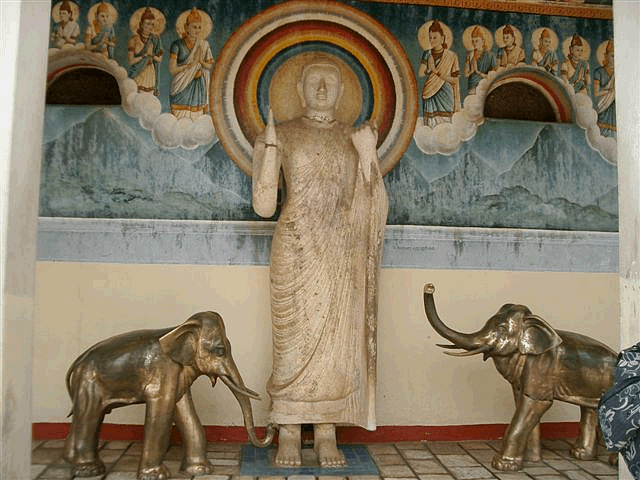
Abb.: Stehender Buddha, Anurādhapura, 20. Jhdt.
[Bildquelle: lizamber. --
http://www.flickr.com//photos/lizamber/72162732/. -- Creative Commons
Lizenz. -- Zugriff am 2006-06-04]
Seated (Vādahun pilimaya), and
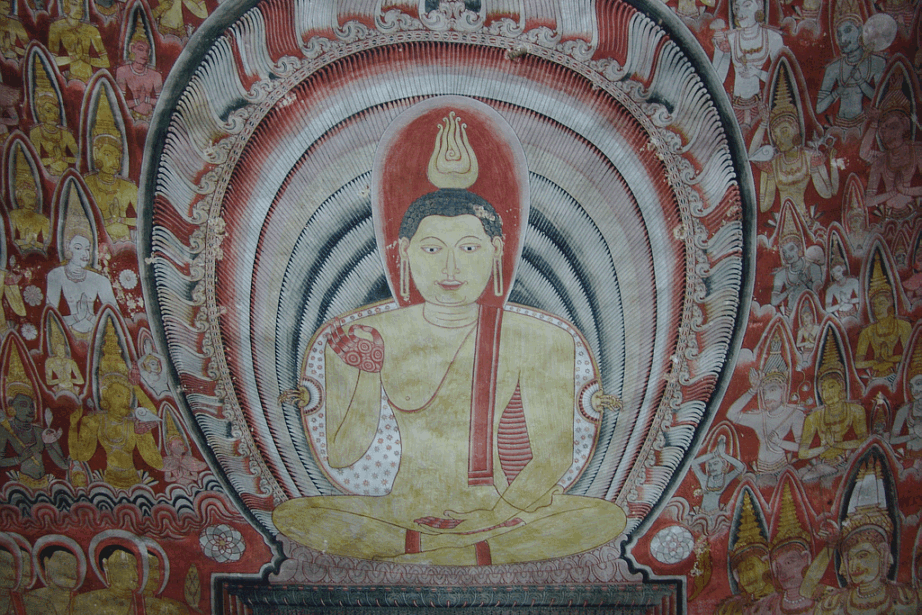
Abb.: Sitzender Buddha, Vitarka-mudrā, Höhle, Dambulla
[Bildquelle: Jungle Boy. --
http://www.flickr.com/photos/jungle_boy/144551141/. -- Creative Commons
Lizenz. -- Zugriff am 2006-06-03]
Recumbent (Hoth pilimaya).
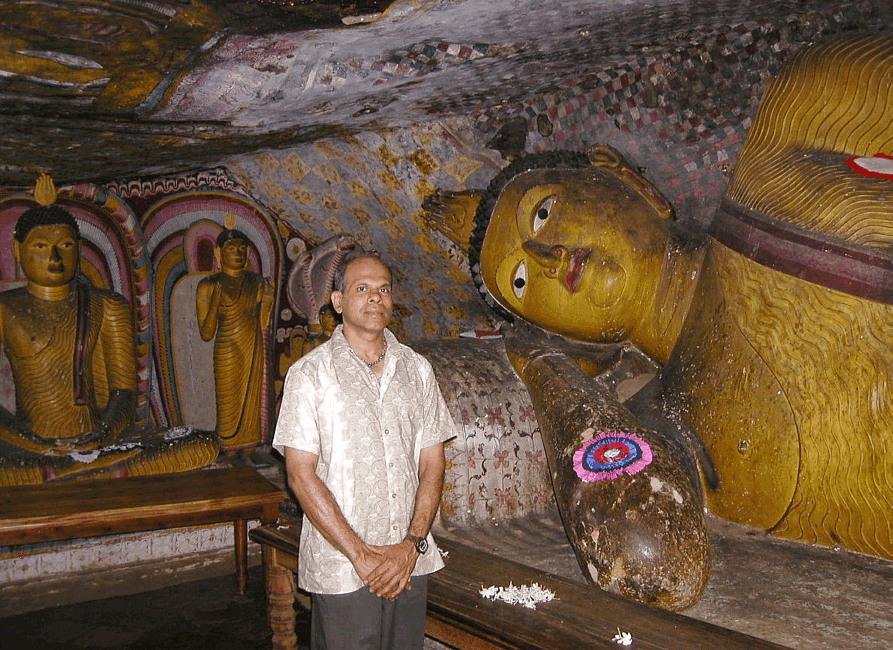
Abb.: Liegender Buddha, Höhle, Dambulla
[Bildquelle: Dennis Sylvester Hurd. --
http://www.flickr.com/photos/dennissylvesterhurd/36236734/. -- Creative
Commons Lizenz. -- Zugriff am 2006-06-03]
In the recumbent position, the Buddha statue is always seen reclining with the head resting on the right palm. It is called the Sinha Seyyāva, or the sleeping posture of a lion, and signifies a man who has destroyed all inclinations towards evil and passion and has become an Arahant.
The seated and the standing statues are depicted with symbolic gestures of the hand (mudrā). According to Hindu tradition there are thirteen Mudrās, but Ceylon sculptors have adopted only five for the Buddha statues. They are as follows:
Bhūmi sparsha mudrāva. In this posture, the hands point down to the earth, signifying that the earth bears witness to the fact that the Buddha attained enlightenment. There is a story connected with this. When the Buddha attained enlightenment, the devil (māraya) came to him and asked for proof of his achievement. Then the Buddha, pointing to the earth, said that the earth was his witness.
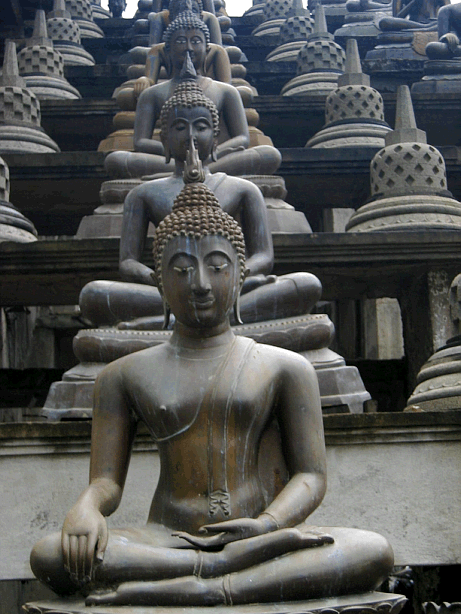
Abb.: Bhūmī-sparṣa-mudrā, Colombo
[Bildquelle: kalyan3. --
http://www.flickr.com/photos/kalyan3/95639467/. -- Creative Commons
Lizenz. -- Zugriff am 2006-06-03]
Abhaya mudrāva. In this posture the arm is bent at the elbow and the hand lifted with the palm facing outward. The famous. Aukana Budu Pilimaya is the best example of this. Abhaya means fearlessness. The abhaya mudrā therefore signifies on the one hand the fearless confidence of the Buddha, and on the other hand his conferring blessings on the people. It is a sign as if the Buddha is saying,, "Stop, come to me, don't be afraid."
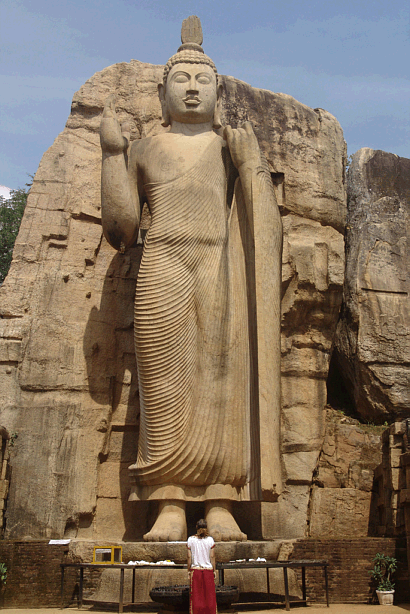
Abb.: Abhaya-mudrā, Aukana, 5. Jhdt. n. Chr.
[Bildquelle: Jungle Boy. --
http://www.flickr.com/photos/jungle_boy/144551142/. -- Creative Commons
Lizenz. -- Zugriff am 2006-06-03]
Vitarka mudrāva. The mudrā depicts the Buddha in an attitude of preaching and is therefore also known as desanā mudrāva. The hand is held up as in the abhaya mudrā, with the first finger touching the thumb.
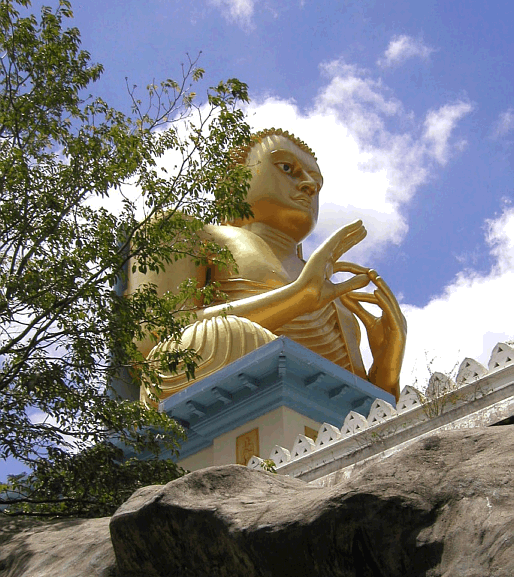
Abb.: Vitarka-mudrā, Dambulla, 20. Jhdt.
[Bildquelle: Dennis Sylvester Hurd. --
http://www.flickr.com/photos/dennissylvesterhurd/36236611/. -- Creative
Commons Lizenz. -- Zugriff am 2006-06-03]
Kataka hasta mudrāva. This is somewhat similar to the
above, with the difference that the middle finger touches the thumb, with the third finger also being bent.
Samādhi or dhyāna mudrāva. In the posture the Buddha is seen seated in meditation, with one hand resting on the up-turned feet and the other hand resting on its palm.This is a very common posture seen in many of the Ceylon Buddha statues. It is the meditative pose of the Yogis and the Jains. The Hindu and Jain influence is here clearly seen. This posture depicts the serene peace and calm of the Buddha who, through perfect self-control subdued all passions of the flesh, bringing into unity mind and body.
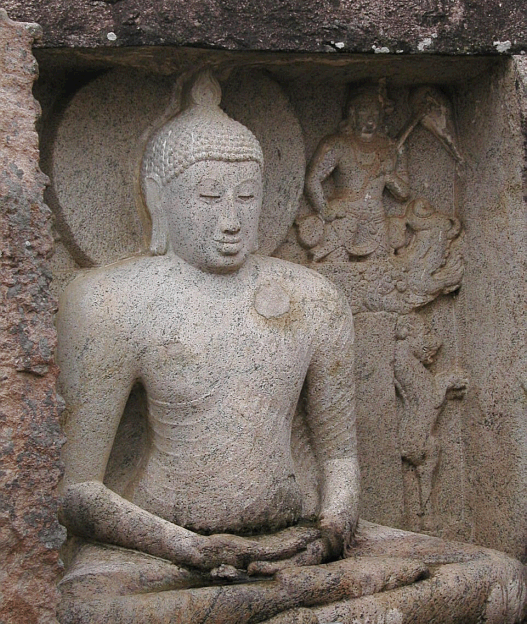
Abb.: Samādhi-Buddha, Tantirimalai
[Bildquelle: Dennis Sylvester Hurd. --
http://www.flickr.com/photos/dennissylvesterhurd/50836074/. -- Creative
Commons Lizenz. -- Zugriff am 2006-06-03]
The Samādhi statue in Anurādhapura, made in the second century A.D., is one of the most awe-inspiring of statues in Sri Lanka. Pandit Jawaharlal Nehru, when he visited Ceylon some time ago, stood spell-bound before this image. Referring to his experience he said: "The Buddha statue at
Anurādhapura in Ceylon moved me greatly and a picture of it has been my companion for many
years." [The Discovery of India, p. 220.] When he subsequently visited Ceylon he was presented with a silver replica of this statue. The
Samādhi statue has now become the venue of an annual festival during Poson, when thousands of devotees range themselves around this statue spell-bound and in silent meditation.
Dharmacakra mudrāva. There is no image in Sri Lanka with this mudrā, but it is one that is commonly seen in books and magazines. It depicts the Buddha preaching the First Sermon. The first finger and the thumb of the right hand touch each other as in the vitarka mudrā, making a circle, and the middle finger of the left hand touches them both. There is a famous image in Saranath with this mudrā.
The Buddha image is treated with the greatest respect. One particular ceremony known as the
Netra pinkama (Eye festival) gives an indication of the high regard and reverence paid to it. The ceremony is an elaborate long-drawn-out one, the most important aspect of which is the ritual of painting the eyes on the
image. It is the last and most important act of the whole Eye festival. In olden days this was probably done by a king or someone of high standing. Today a specialist craftsman is carefully chosen to perform this most sacred and awesome act.
On the day when the ceremony is to take place, the craftsman comes in procession from his home to the place where the image is. He offers prayers to the goddess Gana-devî and a sheaf of betel leaves to the goddess (Bhūmatudevî.) Then he goes to the place where the image is, accompanied by another, who brings a box of colours and a mirror. This mirror is held in front of the image and the craftsman, looking at the mirror, paints the eyes over his shoulders or sideways, without looking at the image. This is done at an extremely auspicious time as the culminating act of a long and elaborate ritual. As soon as the eyes are painted, the sculptor is blindfolded and led to a place where there is water and the covering is removed so that his eyes will first fall on the water. The water is then struck with a sword. This is a symbolical act signifying the destruction of the evil effects of the "look" (bälma).
Behind this symbolical act there is the concept of the dangerous look or gaze. It is believed that the gaze of the image is so powerful that no one must look at it direct. That is why the sculptor uses a mirror. Even then, the sculptor's look can be dangerous until it is symbolically destroyed. After this is done the gaze of the image will have no evil effect.
It is believed that once the eyes are set the image comes alive, so to speak. The
netra pinkama gives life to the image. As Robert Knox put it:
Before the eyes are made, it (the image) is not accounted a God, but a lump of ordinary Metal, and thrown about the Shop with no more regard than anything else.... The Eyes being formed, it is thenceforth a God. [An Historical Relation of the Island of Ceylon, p. 82.]
Mention must also be made of another festival known as the nānumura mangalya, the festival of anointing or bathing the Buddha image. It is a relic of the days of the Sinhalese kings, which is now observed only in a few old temples. However, at the Temple of the Tooth in Kandy, this ceremony takes place every Wednesday.
Certain unguents (nānu) are prepared on a tray. These are
saffron bark (kokum potu)
margosa leaves (kohomba kola),
turmeric (amu kaha),
sesamum (tala),
green gram (mun äta),
punac (mimura),
coconut (pol),
red and white sandalwood (rat and sudu handun), and
all kinds of sour things such as limes (dehi), sour oranges (ambul dodam) and tangerines (nas nāram).
Each of these ingredients is mixed with oil and made into a paste, and a little of each paste is taken and mixed into a paste which is placed in the centre of the tray. This tray is taken in procession to the temple where the Buddha image is. Someone carries it on his head under a canopy. A mirror is also taken. Drums are beaten, oil lamps lit and a conch shell blown. Two or more monks enter the shrine room and kneel before the Buddha image and worship. The chief monk holds the mirror by the head of the image so that its reflection is seen in the mirror. The mirror is then anointed with the paste. The junior monk then pours water over the mirror and the paste is washed away. After this the chief monk offers robes to the Buddha, waves a fan and a yak tail before him and rings a little bell. After each act he bows with folded hands and worships the image. Finally both monks kneel and worship the image. If there are other images this same ritual is repeated in respect of each.
This ceremony is performed by the monks, but there is another ceremony known as the Buddha Pūjā in which laymen participate. This is described in the next chapter.
Image worship is not limited to the temple. Today there is a wide-spread practice of maintaining Buddha shrines in Buddhist homes. About the significance of these household shrines, Bhikkhu Sangharakshita writes as follows:
From the spiritual point of view the household shrine, with its symbol of Enlightenment, stands for the presence of the Unconditioned in the midst of the conditioned, Nirvāna in Samsāra as well as for the presence of the enlightened mind behind the dust and dirt of mundane consciousness. Ultimately it stands for the Unconditioned non-duality of these pairs of opposites. Yet despite the fact that lamps may be lit, incense burned, and flowers and other offerings presented, if not daily, at least on special occasions, the Buddha image or other symbol of Enlightenment is popularly conceived not even as an actual object of worship --b much less still metaphysically -- but rather as a talismanic source of blessing and magical protection. All the same, obscured by secondary considerations though its real signification may be, the practice of maintaining a household shrine is of value to the laity, as providing a constant unobtrusive reminder of the existence of a higher world of spiritual values to the realization of which they ought, as followers of the Buddha, direct themselves. [The Three Jewels, p. 257.]
Here we have an indication of the existential significance of the Buddha image in the devotional life of the Buddhists. To this we may add the words of the German philosopher, Count Hermann Keyserling, who speaks with great feeling when he says:
The East has succeeded in what has never yet been reached in the West: the visible representation of the divine. As such I know nothing more grand in this world than the figures of the Buddha: it is an absolutely perfect embodiment of spirituality in the visible domain. [The Travel Diary of a Philosopher, p. 89.]
Worship of the Buddha has reached a great height today. He has come to occupy a very central place in the religious life of Buddhists. This is seen from two significant developments in recent times.
The first is the replacing of the picture of Sivali with the picture of the Buddha or the Buddha shrine. According to orthodox Buddhist teaching, the Buddha does not answer prayer or grant blessings. The role of bringing blessings and material prosperity to the household was attributed to the Arahant Sivali, a disciple of the Buddha who was declared by the Master to be pre-eminent among the recipients of gifts. It is said that his begging-bowl was never empty and that he brought blessings wherever he went. He thus became more or less a symbol of providence. His picture was therefore kept in Buddhist homes. But today Sivali's picture has been displaced by the Buddha shrine. The ideas associated with Sivali have been transferred to the Buddha.
Another recent development is the rise of Bhakti-Gî or devotional songs, comparable to the Christmas Carols, and are sung specially during the Vesak celebrations. Some of these songs are sung to the tune of Christian hymns. Music and song were never used in adoration of the Buddha; they were used in connection with the worship of devas and demons and for that reason were considered to be expressions of lower cults. But today Bhakti-Gî are sung with musical accompaniments in adoration of the Buddha.
There are Buddhists, orthodox in their outlook and well informed, for whom the Buddha was the greatest man who ever lived, the most enlightened teacher of gods and men, the most reliable guide in all spiritual matters, greater than all gods, but yet a man, and the images are only reminders of that great historical personality who is now no more.
There are Buddhists to whom the Buddha is Devātideva -- the God above God -- who lives, knows and loves, and who is worthy of all adoration.
There are Buddhists to whom the Buddha is neither a God nor a man, but an Ideal or a Spiritual Principle of Buddhahood, the inexhaustible source of inspiration and hope.
But for the average Buddhist, the Buddha is all the above and much more;
in him they find the fulfilment of the human need to worship;
in him they find the person to be loyal to;
in him they find the ultimate authority higher than any human being,
and when they bow in worship before the Buddha image they give expression to the sense of awe and wonder before the Ultimate Mystery of life.
Zurück zu Mahāvamsa, Kapitel 20